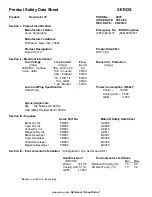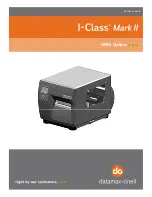
PROGRAMMER’S REFERENCE MANUAL
Printer settings
Page 50
167 <n>
Media position sensor (MPS). The MPS can operate in three different modes,
which may be changed depending on how and where labelgaps are
positioned. The different modes are realized by selecting the inner, outer or
black mark sensor. Note that the number of valid sensor types are different
for Compact and Nova models. This is since Compact has an extra option for
the older inverted black mark sensor type, which still is the most common
type for Compact models.
The selection of MPS is also different for Compact and Nova models. Nova
always uses manual select of MPS type, whereas Compact has an automatic
detect function to see which sensor is currently mounted. The reason for this
is that Compact has different hardware for the different sensor types. Nova
has all types in the same hardware. The automatic detect functionality is the
default behaviour for Compact, to change to manual mode use parameter
170.
Valid values for n are {0, 1, 2, 3} and they are interpreted as follows:
0 = outer gap sensor (default)
1 = inner gap sensor
2 = black mark sensor
3 = inverted black mark sensor (Compact only)
168
4
<n>
Historic control mode. When enabled, historic strobes will automatically be
calculated during printout. Valid values for n are {0, 1} and they are
interpreted as follows:
0 = historic control off
1 = historic control on (default)
Note! This option is not available for older Compact models with the old CPU
board (the ones without USB port)
170 <n>
Sensor detect. This parameter is only used by Compact models to decide
when and if an automatic detection of current media position sensor (MPS)
should be made. Valid values for n are {0, 1, 2} and they are interpreted as
follows:
0 = Autodetect sensor at startup (default when upgrading firmware)
1 = Autodetect sensor at autoadjust (default in future releases)
2 = Manual
If the manual mode is selected then parameter 167 is used to select sensor
type.
178 <n>
Maximum labelwidth, in
1
/
10
mm. This parameter is used in combination with
status register 2 (bit 7, layout outside label) to check if a layout is outside the
label (default) or, if this parameter is set, outside the user defined width. This
feature is useful to verify that a printout is within a certain area of the label.
Valid values for n are {0, 1, … , 1040}. Default is 0.
Note! Parameter 179 must also be specified in order to activate the check.
















































